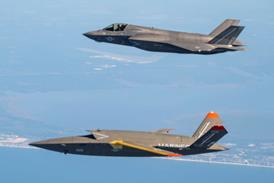CHALLENGING WEIGHT and cost goals have been met by the F-22's armament-system design team while ensuring that the aircraft ultimately will be able to perform missions other than air superiority. The first of those extra missions, near-precision strike using the Joint Direct Attack Munition (JDAM), already has been added to the F-22's design baseline.
Although its primary armament is carried internally, for stealth, the F-22 has four underwing hardpoints, designed to carry fuel tanks and missiles, that give the aircraft expanded capability to perform additional missions, says Merritt Farren, armament team leader.
The design weapon load is four medium-range AIM-120As, or six "compressed-carriage" AIM-120Cs, in the main, underfuselage, weapons bays and two short-range AIM-9Ms in the side bays, plus a 20mm cannon with 480 rounds of ammunition. Although the AIM-120A is the baseline weapon, Farren says, the clipped-fin -120C will be the production missile when the F-22 enters service. Each additional AMRAAM adds 160kg for the missile and 45kg for its launcher, but there is no increase in drag.
The AMRAAM vertical-eject launcher, developed by EDO, replaces the trapeze launcher demonstrated on the YF-22. Farren says the move to an ejector saved weight by shortening the weapons bay. The requirement is to launch the missile in all flight conditions without sway or twist during the eject cycle, because there is no room in the bay. The ejector must push the missile nose-down through the "concrete wall" of boundary-layer air at supersonic speed, he says.
The ejector has a 230mm stroke and launches the missile in less than a second, using pneumatic-hydraulic actuation. An air piston charged by the aircraft's hydraulic system extends the launcher's scissors mechanism. An hydraulic valve releases the missile at the end of the eject cycle, and the launcher retracts. The weapons-bay doors will still close if the ejector remains down, Farren says. Prototype tests with a dummy AIM-120 demonstrated an end-of-stroke velocity approaching 8.1m/s and a peak acceleration of 40g, he says. There is a slow cycle for safe ground operation of the launcher.
The AIM-9 trapeze launcher has been developed for the F-22 by Lockheed Martin Tactical Aircraft Systems (LMTAS), based on the F-16's wingtip launch-rail. The launcher extends rapidly, but does not eject the missile. Instead, the Sidewinder emerges nose-first from the side weapons-bay, to increase the field-of-view of its infra-red seeker. The missile is then launched off the rail, which is angled outward and downward by a few degrees and which incorporates a plume deflector to protect electronics in the weapons bay. Farren says minor launcher changes will be required to accommodate the longer AIM-9X planned for the F-22.
BEHIND CLOSED DOORS
Located above the right inlet and concealed by port and purge doors, which must open for the gun to fire, says Farren, is a modified M61A2 cannon with lighter barrels and breech. An LMTAS-developed linear linkless ammunition-handling system is located behind the main weapons bays, on the aircraft's centre of gravity (CG). Spent shell cases are returned to the ammunition shelves for CG control and to avoid foreign-object damage.
External-stores stations are required for the F-22's ferry mission. Each 2,270kg-capacity underwing hardpoint can carry a 2,270litre (600USgal) fuel tank on a jettisonable pylon. Each pylon can carry, along with the tank, two AIM-120s in ferry condition, with fins removed and stowed in the side bays. Alternatively, each pylon can carry two AIM-120s or AIM-9s on a fireable-missile adaptor which replaces the tank.
Plans to use the F-15 external tank have been dropped and new tank is being developed which is externally similar, but with internal baffling for CG control. The fireable-missile adaptor has been redesigned to avoid flutter, Farren reveals.
All F-22s will be able to carry two 450kg JDAMs internally, one on the inboard side of each main bay, with an AIM-120C alongside. The weapons will be carried on standard EDOBRU-46 bomb racks bolted into the bays. The McDonnell Douglas GBU-32 JDAM global-positioning/inertial-navigation (GPS/INS) guidance tailkit provides 13m accuracy. Target position is programmed into the weapon during mission planning or in flight, and a launch-acceptability footprint is displayed to the pilot.
A weapons-optimisation study has been conducted to improve the capability to carry future munitions in F-22's main bays. Options looked at include two improved JDAMs, which would have better than 3m accuracy; two Lockheed Martin Wind-Corrected Munition Dispensers, which can carry bomblets, mines or sensor-fuzed submunitions; eight small, 115kg precision-guided bombs; or 24 laser-radar-guided autonomous submunitions.
Source: Flight International























